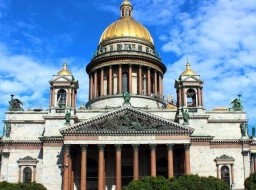At 47 acres (19 hectares) the National Museum of China is among the largest museums in the world. It’s a great place to learn about Chinese culture and the history of long-lost dynasties. You can spend a good part of the day wandering through the museum’s halls.
Upon entry you may feel a bit overwhelmed by the sheer scope of exhibits. You won’t have enough time to see all the items in the collection, which numbers about a million. Start with the rotating exhibits and then move on to the collections that pique your interest most. You can always come back for the free basic exhibits.
After renovation and expansion, National Museum of China has in total 48 exhibition halls, ranging from 800-2,000 square meters (960-2,400 square yards). Ancient China and the Road to Rejuvenation are the main basic exhibitions to show nearly 3,000 historic materials from Yuanmou Man about 1,700,000 years ago to the abdication of the Qing Emperor in 1912 in ten exhibition halls, and modern and contemporary revolutionary relics since the First Opium War (or the First Anglo-Chinese War) in 1840 in nine exhibitions halls, mirroring more than 100 years development of China from 1840 to the founding of the PRC in 1949.
National Museum of China is devoted to display of treasured collections in form of various thematic exhibitions, such as the Arts of bronze, porcelain, jade, Chinese calligraphy and paintings, Buddhist statues, Ming & Qing furniture, coins, etc in ancient China; to display feature culture relics, significant archeological discoveries and ethnic culture and folk customs in the form of exchanges and cooperation with local museums; to display different civilizations and artistic creations in the world in the form of loan and exchange exhibitions. There are temporary exhibition halls to display modern art.
New buildings of National Museum of China during the latest renovation project include several banquet rooms respectively decorated with wood, brick, bronze and stone carvings. In order to provide a variety of services, the new National Museum has shops offering tea, coffee, souvenirs, as well as an auditorium and a 700-seat theater.
Top Treasures
The National Museum of China houses the most cherished and topmost level cultural relics of the whole nation, which can be seen in history schoolbook. The oldest exhibit is the teeth of Yuanmou Man 1.7 million years ago. There are also the stone tools and ancient jade ritual objects of prehistoric times. Simuwu Rectangle Ding, which is the top treasure of the museum is the biggest piece of bronze ware in China. It was discovered in the Yin Ruins Royal Tomb of the Shang Dynasty. The image in the emblem of the National Museum of China is Simuwu Ding. In addition, the 34.5kg bronze Four Ram Zun Vessel of the Shang Dynasty, the Tang Dynasty Tricolor Pottery with Musician and Dancing Figures on Camelback excavated in Xian in 1957 and the Jade Shroud Sewn with Gold Thread for the emperor and nobility of the Han Dynasty are also top treasures of the museum.
Permanent and Regular Exhibitions
- The Road to Rejuvenation (North Galleries N5-N7, N12-N15): from Opium War of 1840 - attempts and achievements at national rejuvenation
- Ancient China (Galleries N20-N25, S15-S18, S20): a complete picture of Chinese history from the prehistoric times to the late Qing Dynasty
- Masterpieces of Chinese Fine Arts (Central Hall 1): paintings and sculptures about historical and revolutionary themes
- Chinese Qing and Ming Furniture (Gallery N9): furniture made of lacquered wood or hardwood of Ming and Qing Dynasty
- Stone Sculptures of Song Dynasty (Public Area): embossments of Song Dynasty unearthed in Sichuan Province showing the ancient people's life and funeral custom
- Ancient Chinese Porcelain (Gallery N17): various porcelains from Zhou to Qing Dynasty
- Ancient Chinese Money (Gallery S11): the objects, including early cowrie shells, coins in different shapes that were used for over 2,000 years, and machine-made copper or silver coins inlate Qing
- Ancient Chinese Jades (Gallery S13): some of the finest jade objects dating from the Neolithic times to the Qing Dynasty to be displayed
- Ancient Chinese Bronze Art (Central Hall 2): those ancient bronzes from the Xia, Shang, and Western Zhou Dynasties to the Spring and Autumn and the Warring States Periods
- Ancient Chinese Buddhist Sculpture (Central Hall 2): including buddhist sculptures once lost overseas, bestowed by the State Bureau for Preservation of Cultural Relics, borrowed from Qingzhou Museum and new collections of this museum




